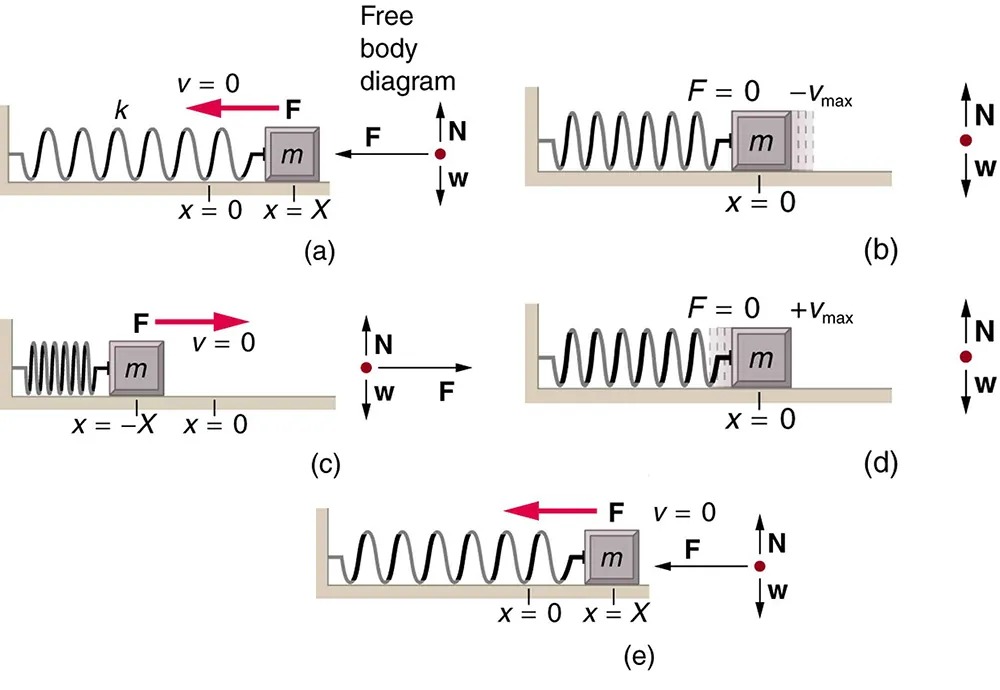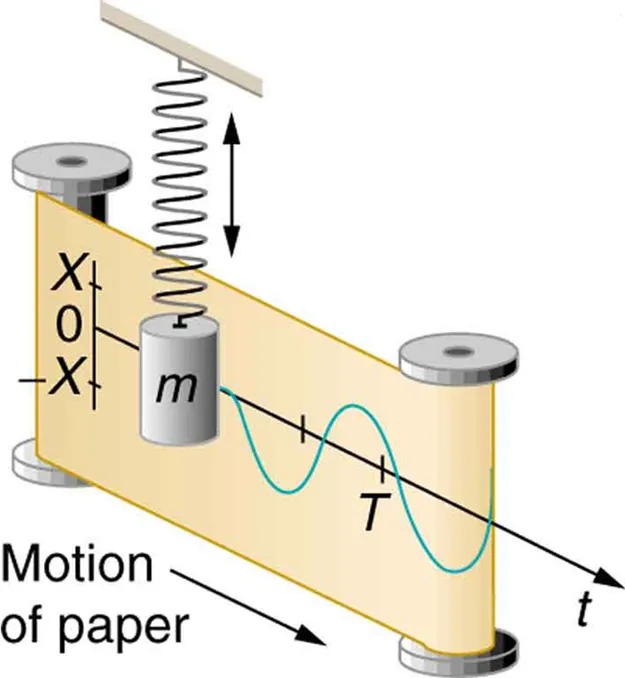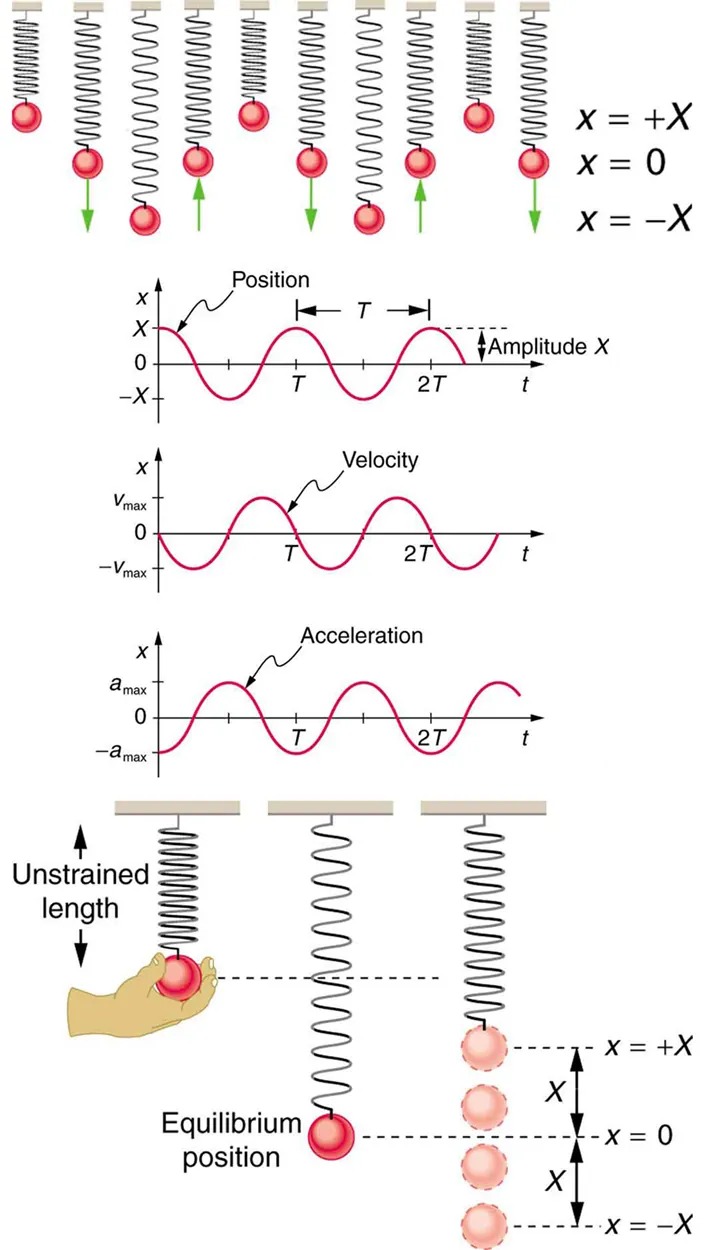13.3 Simple Harmonic Motion: A Special Periodic Motion
Learning Objectives
By the end of this section, you will be able to:
- Describe a simple harmonic oscillator.
- Explain the link between simple harmonic motion and waves.
The oscillations of a system in which the net force can be described by Hooke’s law are of special importance, because they are very common. They are also the simplest oscillatory systems. Simple Harmonic Motion (SHM) is the name given to oscillatory motion for a system where the net force can be described by Hooke’s law, and such a system is called a simple harmonic oscillator. If the net force can be described by Hooke’s law and there is no damping (by friction or other non-conservative forces), then a simple harmonic oscillator will oscillate with equal displacement on either side of the equilibrium position, as shown for an object on a spring in Figure 13.9. The maximum displacement from equilibrium is called the amplitude [latex]X[/latex]. The units for amplitude and displacement are the same, but depend on the type of oscillation. For the object on the spring, the units of amplitude and displacement are meters; whereas for sound oscillations, they have units of pressure (and other types of oscillations have yet other units). Because amplitude is the maximum displacement, it is related to the energy in the oscillation.
Take-Home Experiment: SHM and the Marble
Find a bowl or basin that is shaped like a hemisphere on the inside. Place a marble inside the bowl and tilt the bowl periodically so the marble rolls from the bottom of the bowl to equally high points on the sides of the bowl. Get a feel for the force required to maintain this periodic motion. What is the restoring force and what role does the force you apply play in the simple harmonic motion (SHM) of the marble?

Figure 13.9 An object attached to a spring sliding on a frictionless surface is an uncomplicated simple harmonic oscillator. When displaced from equilibrium, the object performs simple harmonic motion that has an amplitude [latex]X[/latex] and a period [latex]T[/latex]. The object’s maximum speed occurs as it passes through equilibrium. The stiffer the spring is, the smaller the period [latex]T[/latex]. The greater the mass of the object is, the greater the period [latex]T[/latex]. Image from OpenStax College Physics 2e, CC-BY 4.0
Image Description
The image consists of five diagrams labeled (a) through (e), illustrating the motion of a block attached to a spring, showing the forces and velocities at different positions.
- (a) A block with mass m is at position x = X, compressed against a spring with spring constant k. The velocity v is 0, and a leftward force F is shown by an arrow. A free body diagram nearby shows forces: N (normal), w (weight), and F.
- (b) The block is at equilibrium position x = 0. Velocity is -vmax (maximum leftward). No external force F is applied, as indicated by F = 0. A free body diagram shows N and w.
- (c) The block is at position x = -X, with no velocity (v = 0). A rightward force F, shown by an arrow, acts on the block. A free body diagram shows N, w, and F.
- (d) The block is again at equilibrium position x = 0, moving with velocity +vmax (maximum rightward). No external force F is applied. A free body diagram is similar to (b).
- (e) Similar to (a), the block is compressed at x = X with velocity v = 0. A leftward force F is shown, and the free body diagram displays N, w, and F.
What is so significant about simple harmonic motion? One special thing is that the period [latex]T[/latex] and frequency [latex]f[/latex] of a simple harmonic oscillator are independent of amplitude. The string of a guitar, for example, will oscillate with the same frequency whether plucked gently or hard. Because the period is constant, a simple harmonic oscillator can be used as a clock.
Two important factors do affect the period of a simple harmonic oscillator. The period is related to how stiff the system is. A very stiff object has a large force constant [latex]k[/latex], which causes the system to have a smaller period. For example, you can adjust a diving board’s stiffness—the stiffer it is, the faster it vibrates, and the shorter its period. Period also depends on the mass of the oscillating system. The more massive the system is, the longer the period. For example, a heavy person on a diving board bounces up and down more slowly than a light one.
In fact, the mass [latex]m[/latex] and the force constant [latex]k[/latex] are the only factors that affect the period and frequency of simple harmonic motion.
Period of Simple Harmonic Oscillator
The period of a simple harmonic oscillator is given by
[latex]T = 2π \sqrt{\frac{m}{k}}[/latex]
and, because [latex]f = 1 / T[/latex], the frequency of a simple harmonic oscillator is
[latex]f = \frac{1}{2π} \sqrt{\frac{k}{m}} .[/latex]
Note that neither [latex]T[/latex] nor [latex]f[/latex] has any dependence on amplitude.
Take-Home Experiment: Mass and Ruler Oscillations
Find two identical wooden or plastic rulers. Tape one end of each ruler firmly to the edge of a table so that the length of each ruler that protrudes from the table is the same. On the free end of one ruler tape a heavy object such as a few large coins. Pluck the ends of the rulers at the same time and observe which one undergoes more cycles in a time period, and measure the period of oscillation of each of the rulers.
Example 13.4
Calculate the Frequency and Period of Oscillations: Bad Shock Absorbers in a Car
If the shock absorbers in a car go bad, then the car will oscillate at the least provocation, such as when going over bumps in the road and after stopping (See Figure 16.10). Calculate the frequency and period of these oscillations for such a car if the car’s mass (including its load) is 900 kg and the force constant ([latex]k[/latex]) of the suspension system is [latex]6 . \text{53} \times \text{10}^{4} \text{N}/\text{m}[/latex].
Strategy
The frequency of the car’s oscillations will be that of a simple harmonic oscillator as given in the equation [latex]f = \frac{1}{2π} \sqrt{\frac{k}{m}}[/latex]. The mass and the force constant are both given.
Solution
- Enter the known values of k and m:
[latex]f = \frac{1}{2π} \sqrt{\frac{k}{m}} = \frac{1}{2π} \sqrt{\frac{6 . \text{53} \times \text{10}^{4} \text{N}/\text{m}}{\text{900} \text{ kg}}} .[/latex]
13.17 - Calculate the frequency:
[latex]\frac{1}{2 \pi} \sqrt{72.6 / \text{s}^{2}} = 1.3656 / \text{s}^{1} \approx 1.36 / \text{s}^{1} = 1.36 \text{Hz} .[/latex]
13.18 - You could use [latex]T = 2π \sqrt{\frac{m}{k}}[/latex] to calculate the period, but it is simpler to use the relationship [latex]T = 1 / f[/latex] and substitute the value just found for [latex]f[/latex]:
[latex]T = \frac{1}{f} = \frac{1}{1 . \text{356} \text{ Hz}} = 0 . \text{738} \text{ s} .[/latex]
13.19
Discussion
The values of [latex]T[/latex] and [latex]f[/latex] both seem about right for a bouncing car. You can observe these oscillations if you push down hard on the end of a car and let go.
The Link between Simple Harmonic Motion and Waves
If a time-exposure photograph of the bouncing car were taken as it drove by, the headlight would make a wavelike streak, as shown in Figure 13.10. Similarly, Figure 13.11 shows an object bouncing on a spring as it leaves a wavelike “trace” of its position on a moving strip of paper. Both waves are sine functions. All simple harmonic motion is intimately related to sine and cosine waves.

Figure 13.10 The bouncing car makes a wavelike motion. If the restoring force in the suspension system can be described only by Hooke’s law, then the wave is a sine function. Image from OpenStax College Physics 2e, CC-BY 4.0
Image Description
The image illustrates a side view of a car moving over a bumpy surface. The car is drawn in a simple, outlined style, showing a driver inside. The focus is on the car’s front suspension and wheels, which are reacting to road undulations. A blue dashed line represents the path of the wheel over the uneven ground, while a yellow curved line shows the motion trajectory of the car’s suspension response above the wheels. The background is plain to emphasize the car’s dynamics.

Figure 13.11 The vertical position of an object bouncing on a spring is recorded on a strip of moving paper, leaving a sine wave. Image from OpenStax College Physics 2e, CC-BY 4.0
Image Description
This image illustrates a setup featuring a mechanical oscillator with a mass, labeled “m,” attached to a vertical spring. Above the spring, there is a horizontal line with an arrow indicating up and down motion. The mass is positioned in the center of a moving strip of paper, which is rolled onto two cylindrical spools on either side.
The paper moves in a leftward direction, as indicated by an arrow labeled “Motion of paper.” As the mass oscillates vertically, it traces a sinusoidal wave on the paper. The wave is annotated with “X0” at two points on the vertical axis and “T” on the horizontal axis, representing specific measurements related to the motion.
The time, labeled “t,” is indicated along the horizontal path of the paper that moves through the system.
The displacement as a function of time t in any simple harmonic motion—that is, one in which the net restoring force can be described by Hooke’s law, is given by
[latex]x \left(t\right) = X \text{cos} \frac{2 πt}{T} ,[/latex]
where [latex]X[/latex] is amplitude. At [latex]t = 0[/latex], the initial position is [latex]x_{0} = X[/latex], and the displacement oscillates back and forth with a period [latex]T[/latex]. (When [latex]t = T[/latex], we get [latex]x = X[/latex] again because [latex]\text{cos} 2π = 1[/latex].). Furthermore, from this expression for [latex]x[/latex], the velocity [latex]v[/latex] as a function of time is given by:
[latex]v \left(\right. t \left.\right) = - v_{\text{max}} \text{sin} \left(\frac{2π t}{T}\right) ,[/latex]
where [latex]v_{\text{max}} = 2π X / T = X \sqrt{k / m}[/latex]. The object has zero velocity at maximum displacement—for example, [latex]v = 0[/latex] when [latex]t = 0[/latex], and at that time [latex]x = X[/latex]. The minus sign in the first equation for [latex]v \left(\right. t \left.\right)[/latex] gives the correct direction for the velocity. Just after the start of the motion, for instance, the velocity is negative because the system is moving back toward the equilibrium point. Finally, we can get an expression for acceleration using Newton’s second law. [Then we have [latex]x \left(\right. t \left.\right) , v \left(\right. t \left.\right) , t ,[/latex] and [latex]a \left(\right. t \left.\right)[/latex], the quantities needed for kinematics and a description of simple harmonic motion.] According to Newton’s second law, the acceleration is [latex]a = F / m = \text{kx} / m[/latex]. So, [latex]a \left(\right. t \left.\right)[/latex] is also a cosine function:
[latex]a \left(\right. t \left.\right) = - \frac{\text{kX}}{m} \text{ cos } \frac{2π t}{T} .[/latex]
Hence, [latex]a \left(\right. t \left.\right)[/latex] is directly proportional to and in the opposite direction to [latex]x \left(\right. t \left.\right)[/latex].
Figure 13.12 shows the simple harmonic motion of an object on a spring and presents graphs of [latex]x \left(\right. t \left.\right) , v \left(\right. t ),[/latex] and [latex]a \left(\right. t \left.\right)[/latex] versus time.

Figure 13.12 Graphs of [latex]x \left(\right. t \left.\right) , v \left(\right. t \left.\right) ,[/latex] and [latex]a \left(\right. t \left.\right)[/latex] versus [latex]t[/latex] for the motion of an object on a spring. The net force on the object can be described by Hooke’s law, and so the object undergoes simple harmonic motion. Note that the initial position has the vertical displacement at its maximum value [latex]X[/latex]; [latex]v[/latex] is initially zero and then negative as the object moves down; and the initial acceleration is negative, back toward the equilibrium position and becomes zero at that point. Image from OpenStax College Physics 2e, CC-BY 4.0
Image Description
The image illustrates a mass-spring system undergoing simple harmonic motion. It is divided into several parts:
1. Top Section:
– A series of diagrams show a red ball attached to a vertical spring. The ball moves up and down, with arrows indicating the direction of motion.
– Three positions are labeled: x = +X (maximum positive displacement), x = 0 (equilibrium), and x = -X (maximum negative displacement).
2. Middle Section:
– Position Graph: A sine wave shows the position (x) over time (t), with amplitude marked as X. The wave oscillates between +X and -X.
– Velocity Graph: Another sine wave displays the velocity (v) over time, oscillating between maximum positive (vmax) and negative velocity (-vmax).
– Acceleration Graph: A sine wave for acceleration (a) over time, shifting between maximum positive (amax) and negative acceleration (-amax).
3. Bottom Section:
– Depicts the spring at its unstrained length when not under tension. A hand stretches the spring.
– The equilibrium position is shown, with the ball at rest in the middle.
– The ball is again shown at positions x = +X and x = -X, both an equal distance X from the equilibrium position.
This image visually represents the concepts of position, velocity, and acceleration in simple harmonic motion using a mass-spring system.
The most important point here is that these equations are mathematically straightforward and are valid for all simple harmonic motion. They are very useful in visualizing waves associated with simple harmonic motion, including visualizing how waves add with one another.
Check Your Understanding
Suppose you pluck a banjo string. You hear a single note that starts out loud and slowly quiets over time. Describe what happens to the sound waves in terms of period, frequency and amplitude as the sound decreases in volume.
Click for Solution
Solution
Frequency and period remain essentially unchanged. Only amplitude decreases as volume decreases.
Check Your Understanding
A babysitter is pushing a child on a swing. At the point where the swing reaches [latex]X[/latex], where would the corresponding point on a wave of this motion be located?
Click for Solution
Solution
[latex]X[/latex] is the maximum deformation, which corresponds to the amplitude of the wave. The point on the wave would either be at the very top or the very bottom of the curve.
PhET Explorations
Masses and Springs
A realistic mass and spring laboratory. Hang masses from springs and adjust the spring stiffness and damping. You can even slow time. Transport the lab to different planets. A chart shows the kinetic, potential, and thermal energy for each spring.

